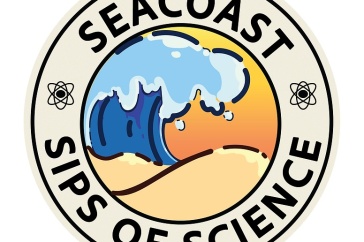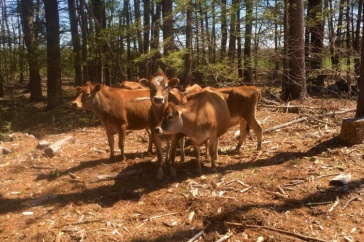
|
|
The potential reversal of the Portland-Montreal oil pipeline has eluded the spotlight that shines on other tar sands oil projects like Keystone XL pipeline. Kaity Thomson ’14 aims to change that.
Packing a one-two punch of scientific research and advocacy, the environmental science major wants those living along the pipeline to know the risks that the project could pose to their drinking water, property values, and recreation.
To do so, Thomson and local environmental activist Brett Chamberlin took a seven-day trip along the pipeline across Vermont, New Hampshire and Maine earlier this month, talking to members of adjacent communities about the project and experiencing up-close the landscape that it would affect.
The 236-mile World War II-era pipeline was built to carry crude oil from South Portland to refineries in Montreal; its owner has proposed to reverse its flow to bring diluted bitumen, better known as tar sands oil, from western Canada via Montreal to the Atlantic port. Researchers and activists say the oil’s properties, and the increased pressure needed to transport it, make oil sands pipelines more likely to rupture.
“A spill in a waterway is not a quick fix,” Thomson says, pointing to the 2010 tar sands pipeline spill that closed a section of the Kalamazoo River in Michigan for two years. This month’s chemical leak in West Virginia, which affected the water supply of 300,000 citizens, provides a more recent cautionary tale.
The landscape along the pipeline’s path, and the ecosystem services it provides, was the subject of Thomson’s research project, “Environmental and Socioeconomic Consequences of Tar Sands in New Hampshire.” She identified and mapped the New Hampshire waterways – including the Connecticut, Androscoggin and Israel rivers -- that would be compromised by a spill from the pipeline. In New Hampshire alone, the pipeline crosses rivers or streams 80 times, she found.
But Thomson was not content with producing research papers and posters to share with classmates and colleagues. So with funding from the National Wildlife Federation’s National Wildlife Campus Ecology Fellowship, Thomson and Chamberlin (son of professor of electrical and computer engineering Kent Chamberlin) traveled along the pipeline from North Troy, Vt., on the Canadian border, to its terminus in South Portland, Maine. They hiked or snowshoed along the pipeline for several miles each day, then met with abutting community members, business owners, and even a few reindeer.
“We found a lot of businesses that were interested or concerned,” says Thomson. One, the owner of an outdoor adventure company in western Maine just downstream from where the pipeline crosses the Androscoggin River, told her he would be “instantaneously out of business” if the pipeline spilled oil. At Santa’s Village in Jefferson (home of those reindeer), an owner shared a sentiment Thomson and Chamberlin heard repeatedly: The Portland Pipe Line Corporation has been a good neighbor, but they want to be kept informed about potential changes and the risks involved.
“A big concern [of community members] is not wanting someone to come in here and tell them what to do,” says Thomson. “They want to be brought to the table. If there are these risks involved, they want to be aware.”
Their trip also nurtured a profound connection with the environment through which the pipeline runs, from the boreal forest of Vermont’s Victory State Forest, home to black bears and 130 species of birds, to the vast recreational resource of Maine’s Sebago Lake, the source of drinking water for 15 percent of that state’s population. “I’m always amazed by the natural landscape we have here and how integrated it is into people’s health and happiness,” Thomson says.
|
|
Thomson’s path to UNH is far less straightforward than the pipeline’s route. A Hampstead native, after high school she fled “this gosh-darned state as fast as my feet would take me,” she jokes, moving to New York City to study dance at The New School.
It was on the streets of New York that Thomson rekindled her passion for the environment. “Being in such an urban area, I realized how important it is to make people aware of how crucial the environment is,” she says.
Drawn to UNH by its reputation for fostering undergraduate research, Thomson’s desire to pursue both science and advocacy took her to research associate professor of climatology and glaciology Cameron Wake, who became her advisor. “I wanted to work with someone who was a great role model for the kind of scientist and communicator I want to become,” she says of Wake and his advocacy on climate change issues.
Wake lauds Thomson for her willingness to merge science and outreach. He steered her toward NH EPSCoR’s Research Experience for Undergraduates program, which supported her research.
“The new challenges we face require scientists to be engaged, and that is what is so wonderful about Kaity,” he says. “The real gem of her approach is that she’s figuring out how to integrate the science and the advocacy. There’s a tension there, but it’s a tension that scientists should be prepared to deal with. That Kaity’s doing this as an undergraduate is impressive.”

Since returning from their trek, which they blogged for the National Wildlife Federation, Thomson and Chamberlin have extended their message with media interviews and presentations, including one at UNH. Thomson plans to expand her research of the pipeline’s impact on ecosystem services to Vermont and Maine, and hopes to secure funding to look in-depth at one particular ecosystem. Longer term, she has her sights set on graduate school, possibly at UNH, to boost her understanding of the science that fuels her advocacy.
“This has been a big undertaking and a fun undertaking. I’ve been able to further my understanding of the kind of research I want to do, and to do something that’s useful to the communities,” she says, adding that coming to UNH was what brought this project to fruition. “I can’t thank UNH enough for being so supportive of my research. When you set your mind to something, UNH is really there to help make it happen.”
-
Written By:
Staff writer | Communications and Public Affairs





















































